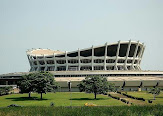Gombe State had in the past years faced devastating floodings in several communities which resulted in deaths and loss of significant wealth.
For instance, last year, flood disasters that occurred in various local government areas killed three persons and displaced many according to official reports.
This was just as it killed seven animals and destroyed estimated 1,838 houses, 257 farmlands and injured 22 persons. Worst affected local governments were; Akko, Funakaye, Balanga, Gombe, Nafada, Kaltungo, Shongom, and Yamaltu/Deba.
Our correspondent reports that Gombe State has 11 local government areas. Apart from flood, Gombe is also bedeviled by gully erosions which destroy hundreds of houses in parts of the state every rainy season.
Some of the most vulnerable communities in the metropolis are; Bomala, Madaki north, Madaki south, Kwarin Misau, Pantami, Unguwa Uku, Barunde, Yelenguruza etc.
The Nigerian Metrological Agency (NiMet) had warned that in this year, 13 states of the federation would witness serious floodings. Gombe State is one of the states predicted to experience flooding.
Gombe State has been no stranger to the devastating effects of flooding. However, the state government has taken proactive measures to prevent a repeat of such disasters.
In a bid to mitigate the impact of flooding, the Gombe State government has launched a dredging exercise to clear major storm drains in the state capital, particularly in vulnerable areas.
The exercise, which was flagged off by Governor Inuwa Yahaya, aims to ensure free flow of water, safeguard the environment, and prevent outbreak of diseases in the communities.
The governor explained that the indiscriminate disposal of waste in major storm drains has been a significant cause of flooding in the state.
He lamented that despite efforts to enlighten and sensitize communities on the dangers of improper waste disposal, the state continues to face significant challenges in that regard.
To address this challenge, the government has also commenced the construction of refuse dump centers to prevent waste disposal in culverts and drains.
The governor emphasized that the government would conduct annual, dredging, desilting and clearance of drainages to prevent flood disasters.
Gombe State has also made significant progress in environmental conservation efforts, including erosion control projects, tree planting campaigns, and provision of financial support to boost climate resilience.
The government has worked diligently to safeguard the livelihoods of the people through sustained collaborative efforts with partners like the defunct NEWMAP and ACReSAL.
The commissioner for water, environment, and forest resources, Mohammed Fawu, explained that the government plans to desilt and dredge 23 kilometers of major drains in the first phase, with an additional 60 kilometers to be desilted in collaboration with the North East Development Commission (NEDC).
The community has applauded the governor’s initiative, and traditional leaders have assured their support in ensuring the success of the project.
The Gombe State Project Coordinator of ACReSAL, Sani Jauro, disclosed plans to rehabilitate the existing mega dump site and create employment opportunities for youth through the ACReSAL project.
As the rainy season sets in, Gombe State’s efforts to prevent flooding are a testament to the government’s commitment to the wellbeing of its citizens.
But only time will tell if these efforts will be enough to mitigate the impact of flooding in the state.






















![#Edodecides2024: Obaseki calls for calm, hints at legal action [VIDEO]](https://thediscovererng.com/wp-content/uploads/2024/09/download-6-3-120x86.jpeg)





